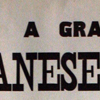In 2007 the Special Collections Department of the University of Saskatchewan Library acquired a collection of 40 early posters printed by the Watson Witness during the period 1908-1912. The Witness was a weekly newspaper established in 1907 in Watson, Saskatchewan, a small town northwest of Big Quill Lake. The collection provides a fascinating glimpse of local events in a small community during the settlement period.
The Watson Witness was established by G.H. Cameron, an American who sought his fortune in Western Canada after his printing business in Lyam, Massachusetts, was destroyed by fire. At the time of the paper’s founding Watson's population numbered less than 200. In 1909 weekly newspapers like the Witness were being produced in 84 Saskatchewan towns and villages.
Watson’s most recent history book, A Century of Progress: Watson and District (2003) describes the labour intensity of a print operation.
“The type was handset, which meant that one letter at a time was put into place by hand. The type was kept in cases containing compartments of various sizes, the letters used most often being in compartments close to the typesetter. Each letter was put into a composing stick, letter by letter, line by line. News items and advertisements were then made up into columns and pages locked into formes. The forme was then transferred to a printing press where it was inked and as the press operated the blank sheets of paper were pressed onto the inked type.”
It was difficult for many local papers to sustain themselves in communities whose growth had stuttered after the initial boom. Beyond subscription revenue, most small papers were limited to a few sources of advertising from local merchants and professionals. Some ads appear to have been placed more to maintain a valued community voice than to expand business.
To supplement income it was a near universal practice to solicit job printing work including the production of posters, handbills and programs. These publicized local events including dances, theatrical entertainments, sports events, political meetings and auction sales.
Small newspaper shops were creatively constrained by the limited equipment available. Most newsprint shop designers could only play with the size and fonts of available type, the spacing and justification of typed lines, and the incorporation of whatever limited printing ornaments and stock engravings might be at hand.
Examples in the Watson Witness gallery indicate that additional variety was provided by the use of coloured newsprints and by the cutting of posters to a number of sizes.
|






